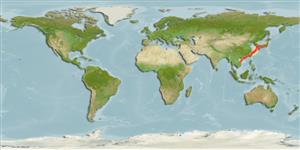Actinopterygii (ray-finned fishes) >
Perciformes (Perch-likes) >
Mullidae (Goatfishes)
Etymology: Upeneus: Greek, ypene, -es = upper lip (Ref. 45335).
Environment / Climate / Range
Ecology
Marine; reef-associated; depth range 4 - 200 m (Ref. 28016), usually 4 - 90 m (Ref. 98481). Subtropical, preferred ?
Western Pacific: W Malaysia and the Philippines to South Korea and Peter the Great Bay, Russia (Ref. 98481). Records from more southern areas are probably mainly misidentifications of Upeneus guttatus (Day) or Upeneus sundaicus (Bleeker).
Size / Weight / Age
Maturity: Lm ? range ? - ? cm
Max length : 15.7 cm SL male/unsexed; (Ref. 10687); common length : 20.0 cm TL male/unsexed; (Ref. 5450)
Dorsal
spines
(total): 7. This species is distinguished by the following characters: D VII + 9; pectoral fins 13-15; gill rakers 6-8 + 18-21 = 24-28. Adult measurements as %SL: body depth at first dorsal-fin origin 21-25 and at anus 18-22; caudal-peduncle depth 8.0-11; maximum head depth 18-21 and through eye 15-17; head length 27-31; orbit length 6.1-8.2; upper jaw length 9.7-12; barbel length 18-23; caudal-fin length 25-29; anal-fin height 15-19; pelvic-fin length 19-23; pectoral-fin length 21-25; first dorsal-fin height 20-24 and second dorsal-fin height 15-19. Colouration: upper caudal-fin lobe in fresh fish with 3-4 red oblique bars while lower caudal-fin lobe almost entirely covered by a broad red stripe that becomes darker distally and is partially surrounded by a dark grey line and by a contrasting white fin margin and white lobe tip exteriorly; there are only weak indications of upper caudal fin lobe bars in preserved specimens with a dark pigmented zone remaining distally at the lower lobe; barbels are yellow; without lateral body stripes; head and body white or silvery ventrally and laterally, sometimes covered with red blotches, and uniformly red dorsally of lateral line; preserved fish are pale brown or brown (Ref. 98481).
Widespread in sandy regions (Ref. 9137). Minimum depth from Ref. 098481.
Life cycle and mating behavior
Maturity | Reproduction | Spawning | Eggs | Fecundity | Larvae
Randall, J.E., M.L. Bauchot and P. Guézé, 1993. Upeneus japonicus (Houttuyn), a senior synonym of the Japanese goatfish U. bensasi (Temminck et Schlegel). Jap. J. Ichthyol. 40(3):301-305. (Ref. 10687)
IUCN Red List Status (Ref. 115185)
CITES (Ref. 94142)
Not Evaluated
Threat to humans
Harmless
Human uses
Fisheries: minor commercial
More information
Common namesSynonymsMetabolismPredatorsEcotoxicologyReproductionMaturitySpawningFecundityEggsEgg development
ReferencesAquacultureAquaculture profileStrainsGeneticsAllele frequenciesHeritabilityDiseasesProcessingMass conversion
Tools
Special reports
Download XML
Internet sources
Estimates of some properties based on models
Phylogenetic diversity index (Ref.
82805): PD
50 = 0.5000 [Uniqueness, from 0.5 = low to 2.0 = high].
Bayesian length-weight: a=0.01023 (0.00654 - 0.01602), b=3.10 (2.97 - 3.23), in cm Total Length, based on LWR estimates for this species & Genus-body shape (Ref.
93245).
Trophic Level (Ref.
69278): 3.6 ±0.38 se; Based on food items.
Resilience (Ref.
69278): High, minimum population doubling time less than 15 months (K=0.6).
Vulnerability (Ref.
59153): Low vulnerability (22 of 100) .
